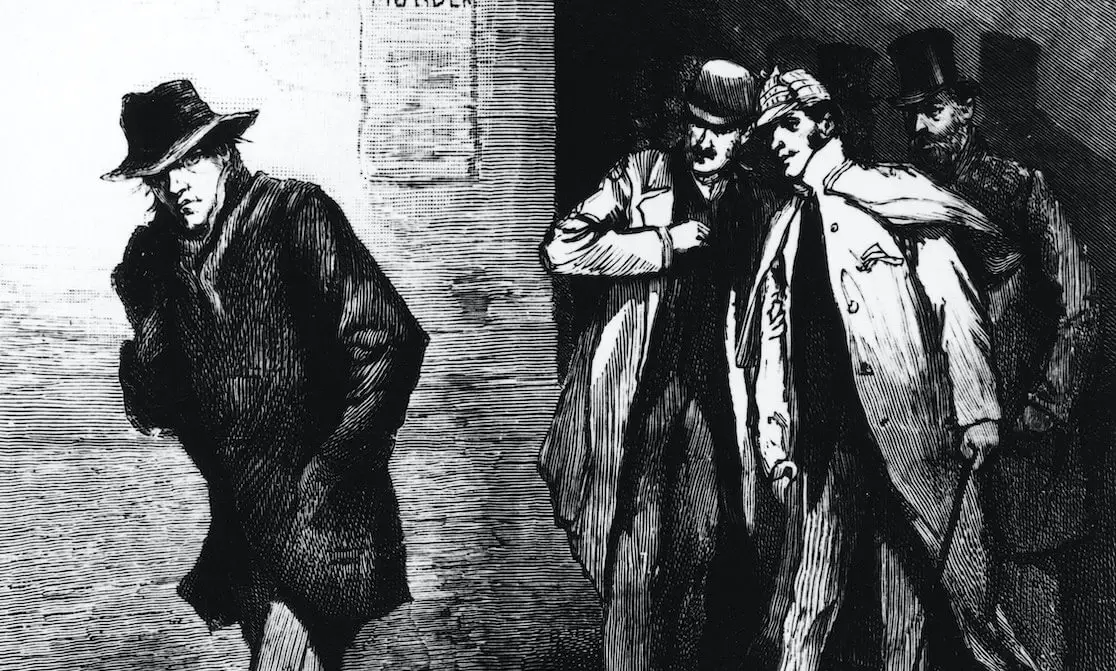In what can only be described as one of the most groundbreaking developments in criminal history, the true identity of one of the world’s most notorious serial killers—Jack The Ripper—has finally been revealed. For decades, the brutal and mysterious figure who terrorized and mutilated London’s women in 1888 remained an enigma, his identity lost to time and speculation. However, recent breakthroughs in forensic science and historical research have provided the definitive answer: Jack The Ripper was a man named Aaron Kosminski.
A Historic Discovery Through DNA
The revelation came about thanks to a shawl, an artifact long associated with the Ripper’s gruesome crimes, which came into the possession of historian Russell Edwards. Believed to have been at the scene of one of the murders, the shawl was subjected to advanced DNA analysis. Edwards assembled a team of experts to extract and analyze genetic material from the fabric. After rigorous testing and confirmation from multiple sources, including a thorough review by forensic scientists, the DNA was matched to Aaron Kosminski—an identification that, according to The Daily Mail, is now 100% confirmed.
Who Was Aaron Kosminski?
Aaron Kosminski was a Polish immigrant who arrived in London and worked as a barber. He was just 23 years old when he is believed to have embarked on his killing spree, targeting vulnerable women in the impoverished districts of Victorian London. At the time of the Ripper murders, Kosminski was one of several suspects, but he was never conclusively linked to the crimes—until now.
Kosminski’s life took a tragic turn long before his alleged series of crimes came to an end. After being identified as a primary suspect, he was confined to a mental institution, where he eventually died in 1919. The grim trajectory of his life, coupled with his mysterious disappearance from public records after the murders, has fueled much speculation over the years. Today, however, the dust has finally settled on one of history’s most enduring mysteries.
The Shawl: A Crucial Piece of Evidence
The pivotal artifact in this case is the shawl that Edwards came into possession of nearly 20 years ago. It was this seemingly ordinary piece of fabric—steeped in historical significance—that provided the key to unlocking the Ripper’s identity. The shawl, believed to have been present at the scene of one of the murders, contained trace amounts of DNA that, when analyzed using modern forensic techniques, pointed directly to Kosminski.
In a remarkable act of historical collaboration, Kosminski’s oldest brother’s great-great-granddaughter provided a DNA sample that was instrumental in confirming the match. This intergenerational link added an extra layer of credibility to the findings, bridging the gap between past and present. The painstaking work undertaken by Edwards and his team culminated in a breakthrough that not only solves a longstanding mystery but also brings a measure of closure to the descendants of the victims.
A Step Toward Justice and Closure
For many, the unmasking of Jack The Ripper has always been more than just a matter of historical curiosity—it represents a quest for justice for the victims who suffered at his hands. One of the great-great-great-granddaughters of one of the victims, Catherine Eddowes, shared with The Daily Mail that naming the real person responsible for these heinous acts is a form of justice. “Having the real person legally named in a court, which can consider all the evidence, would be a form of justice for the victims,” said Karen Miller, echoing the sentiment of many who have long sought answers.
This revelation has also paved the way for a judicial inquest. Edwards and his team have reached out to Britain’s High Court to reopen the investigation into the murders. If the inquest proceeds, it could lead to a formal legal declaration that identifies Aaron Kosminski as Jack The Ripper—a historic moment that may, in time, inspire a Netflix origin story featuring the dark and twisted journey of this infamous figure.
Historical Impact and Future Narratives
The identification of Aaron Kosminski as Jack The Ripper is not just a forensic triumph; it is a moment that reshapes our understanding of one of history’s most notorious criminal cases. The Ripper’s reign of terror in 1888 has long been the subject of countless books, films, and theories, yet his true identity had remained elusive. This breakthrough not only provides clarity but also invites a reexamination of the events that transpired on the foggy streets of Victorian London.
The story of Aaron Kosminski, a troubled immigrant and barber who became one of the most feared figures in criminal history, offers a poignant glimpse into the darker aspects of society during a time of rapid change and social upheaval. His life, marked by isolation, mental illness, and ultimately confinement, reflects the complexities of a period in history where poverty, immigration, and urban decay converged to create conditions ripe for horror.
Moreover, this discovery challenges long-held assumptions and opens the door for a new generation of historical inquiry. Scholars and true crime enthusiasts alike will undoubtedly revisit the Ripper case with fresh perspectives, utilizing modern technology and historical records to further understand the context in which these gruesome crimes were committed.
Public Reaction and Media Buzz
Unsurprisingly, the news of Jack The Ripper’s true identity has sparked a flurry of reactions online and in the media. Fans of true crime, historians, and casual readers alike are abuzz with excitement at the prospect of finally knowing who was responsible for one of history’s most infamous series of murders. Social media platforms have been flooded with discussions, debates, and even memes celebrating the unraveling of this age-old mystery.
For some, the revelation is a bittersweet moment—one that brings long-awaited answers but also revives the tragic memories of the victims. The identification of Kosminski has been hailed as a milestone in forensic history, demonstrating how modern science can illuminate even the darkest corners of the past. Others, however, question the implications of re-opening such a cold case and what it might mean for historical interpretations of Victorian society.
Regardless of the varied opinions, there is a consensus that this development represents a significant achievement in the field of forensic investigation and historical research. The painstaking work of Edwards and his team, combined with the cooperation of Kosminski’s living descendants, has yielded a result that will be studied and discussed for years to come.
Ethical and Legal Considerations
With the potential reopening of a judicial inquest to formally name Aaron Kosminski as Jack The Ripper, ethical and legal considerations are now at the forefront. The process of re-investigating historical cases raises complex questions about how modern legal frameworks can be applied to events that occurred over a century ago. It also touches on issues of historical accountability and the rights of the descendants of both the victims and the accused.
Karen Miller’s comment—that having the killer’s name legally recorded in a court would serve as justice for the victims—resonates with many who believe that historical wrongs deserve formal acknowledgment and redress. However, the prospect of a legal inquest also brings to light the challenges of gathering reliable evidence from a time when forensic science was in its infancy. The rigorous standards required for a modern court of law mean that every piece of evidence, from DNA samples to historical documents, must be meticulously verified and contextualized.
This delicate balance between seeking justice and respecting historical complexities is a challenge that legal experts and historians will need to navigate carefully. Nevertheless, the successful identification of Kosminski through DNA evidence represents a major step forward in this process, potentially setting a precedent for how other unresolved cases from the past might be approached in the future.
The Cultural Legacy of Jack The Ripper
For over a century, Jack The Ripper has been more than just a name—it has become a cultural icon, a symbol of terror and mystery that has permeated literature, film, and popular culture. The very myth of the Ripper has inspired countless works of fiction and non-fiction, each exploring the dark underbelly of Victorian London. Now, with his true identity revealed, the narrative surrounding Jack The Ripper is poised to shift dramatically.
This discovery not only demystifies the legend but also invites a more nuanced discussion about the societal conditions that gave rise to such a figure. Aaron Kosminski’s background as a Polish immigrant and his struggles in a harsh urban environment offer insights into the social and economic factors that may have contributed to his descent into criminality. His story, tragic as it is, reflects broader themes of alienation, mental illness, and the vulnerabilities of a rapidly changing society.
In many ways, the revelation of Kosminski’s identity challenges us to rethink the legacy of Jack The Ripper. It forces us to confront the human dimensions of a figure who, for so long, existed only as a shadowy specter in the annals of history. This newfound clarity may well lead to a reexamination of other historical mysteries and an increased interest in applying modern forensic techniques to unresolved cases.
Conclusion: A Historic Breakthrough and a New Chapter in Forensic History
The unmasking of Jack The Ripper as Aaron Kosminski marks a historic breakthrough in one of the world’s most infamous criminal cases. Thanks to the dedicated work of historian Russell Edwards, a valuable shawl, and the power of modern DNA analysis, the mystery that has haunted London for over 130 years has finally been solved. This discovery not only provides long-awaited answers for the victims’ families and descendants but also sets the stage for a potential judicial inquest that could formally name Kosminski as the Ripper in a court of law.
For historians, forensic scientists, and true crime enthusiasts alike, the identification of Kosminski is a moment of vindication—a reminder that even the most enduring mysteries can eventually be unraveled with persistence, innovation, and the courage to question long-held assumptions.
As this groundbreaking discovery continues to be discussed and debated, its impact will likely be felt for generations. The story of Aaron Kosminski, a troubled immigrant whose life ended in a mental institution in 1919, now takes on new dimensions, offering insights into the societal conditions of Victorian London and the complex interplay of factors that can give rise to such dark legends.
Ultimately, the true significance of this breakthrough lies not just in the unmasking of a notorious criminal, but in the promise it holds for justice and historical truth. For the families of the victims—whose voices have long been silenced by the passage of time—this revelation offers a measure of closure, a chance to finally name the monster who inflicted unspeakable horrors. As Karen Miller poignantly stated, “Having the real person legally named in a court would be a form of justice for the victims.”
In the years to come, the legacy of Jack The Ripper will be redefined by this discovery. What was once a shadowy figure of myth and terror is now a man with a name and a history—a man whose life and actions can be scrutinized with the benefit of modern science and historical research. It is a testament to the enduring power of inquiry and the relentless pursuit of truth that, even after more than a century, we can still uncover the secrets of our past.
As we reflect on this monumental breakthrough, it becomes clear that the pursuit of justice and historical accuracy is a journey that never truly ends. The unmasking of Aaron Kosminski as Jack The Ripper is a powerful reminder that, with the right tools and an unwavering commitment to truth, even the most elusive mysteries can be solved. May this discovery pave the way for future investigations and inspire a deeper understanding of our shared history.

